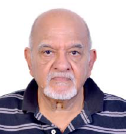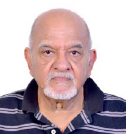Day 1 :
- Advancements in Digestive Disease Treatment | Gastrointestinal Oncology| Liver diseases & Transplantation | Micro biome in Gastrointestinal & Liver | Gallstones | Inflammatory Bowel Disease | Haemorrhoids
Location: Webinar
Session Introduction
Prakash S Bisen
Scientific Advisor
Title: Probiotics and Central Nervous System

Biography:
Professor Prakash S Bisen, D.Sc. F.N.A.Sc. Honorary Professor, School of Studies in Biotechnology, Jiwaji University, Gwalior – 474011, Date and Place of Birth: 11 January, 1948 (Jhansi, U.P.), Former Director, Madhav Institute of Technology and Science, Gwalior, Former Member, University Grants Commission, New Delhi, Former Vice Chancellor, Jiwaji University, Gwalior, Former Member Task Force, All Indian Council for Technical Education, New Delhi, Former Member, CBSE, New Delhi, Former Member, NEIPA, New Delhi, Former Dean, Academic Planning and Development, Bundelkhand University, Jhansi UP.
Abstract:
There has been a lot of research about the human microbes, some detailed investigations of the gastrointestinal microorganisms and its functions, and the highlighting of complex interactions between the gut, the gut micro biome, and the central nervous system. That acquire the involvement of the micro biome in the pathogenesis of various diseases. The gut micro biota is sensitive to internal and environmental influences, we have speculated that among the factors that influence the formation and composition of gut micro biota during life. Micro biome in human system is unequally distributed in the body and includes the aggregate of all microorganisms.
The most abundant micro biome in our body is gastrointestinal track. Which contain number of species of different microorganisms, among them (adults) Bacteroidetes, Actinobacteria and Firmicutes are dominate. The gastrointestinal micro biota is well studied than other human bacterial communities. There are studies have shown that, how exactly the intestinal micro biota has an impact on the health of its host.
Human gastrointestinal tract showed biggest associations of host, environments, and antigens. During the average human lifetime, tons of food transfer through the gut, with complex of microorganisms from the ambient environment, which poses threat on the intestinal entirety. Gut micro biome play a pivotal role in keeping up the resistance and the metabolic homeostasis effective and are protect against pathogenic microbes. Gut micro biota is an crucial modulator of brain development and subsequent adult behavior, and pathogenic microbes can be a reason of inflammatory diseases of the central nervous system. Epidemiological research have been shown a link between microbial infections early in life and neurological disorders, including autism and schizophrenia. The gut microbes can change the immune response by activating the immune system or through mediators that are able to penetrate the blood-brain barrier (BBB) or through other chemicals-related substances that have free access to the brain.
The Probiotics microbes offers numerous bonuses to the host, due to physiological capacities such as harvesting energy, strengthening gut integrity or shaping the intestinal epithelium protecting against pathogens and modulating host immune system. Research showed that, Microorganisms which live inside our gut are beneficial for the proper development of the central nervous system, for brain response and the regulation of host physiology, the ecosystem in the human gut is divers, there is potential for these processes to be disordered because of a changed microbial composition, which can be improved by daily up take of probiotics
The Probiotics microbs offers numerous bonuses to the host, due to physiological capacities such as harvesting energy, strengthening gut integrity or shaping the intestinal epithelium, protecting against pathogens and modulating host immune system. Research showed that, Microorganisms which live inside our gut are beneficial for the proper development of the central nervous system, for brain response and the regulation of host physiology, the ecosystem in the human gut is divers, there is potential for these processes to be disordered because of a changed microbial composition, which can be improved by daily up take of probiotics
Devina Sharma
Broadgreen University Hospitals
Title: Retrospective audit on the use of hypertonic saline in the management of acute symptomatic hyponatraemia in hospitalised patients
Biography:
Devina Sharma from Uk she is an researcher in the hyponatraemia.
Abstract:
Introduction
We introduced the hospital policy on the management of severe symptomatic hyponatraemia (SSH), with hypertonic saline (HS)of 1.8% and 5% saline in 2017. This is one of the few UK centres to offer this treatment, therefore the evidence is limited. The policy was based on European and American guidelines (1)(2). Objectives To study the adherence, and effectiveness, of this guideline in managing patients with SSH.
Methods
Patients were identified using the Biochemistry tracking system between 01/01/18 until 14/05/20. The terms - Hypona, sod, Hypertonic, 5%, 1.8% a were searched. The laboratory result system was used to identify hyponatraemic (<130 mmol/L) patients at the time they were logged onto the tracking system. Clinical notes were crossmatched for the use of 1.8% and 5% saline for those with sodium <130mmol/L. 12 patients were identified. The following data was collected using hospital records: age, gender, location, fluid status, presentation, symptoms after HS adminsitration, volume and type of fluids. Sodium was recorded; prior to and during presentation, after HS saline, at 24, 48 hours and at discharge or death. Cause of death (if applicable), complications of HS and lenght of admission after treatment were also noted. This was compared to the 2017 current hospital guideline. Standard 1: 11 patients had symptoms of hyponatraemia. They were confusion (6), somnolence (5), seizure (4), vomiting (3). Other sympotms included muscle twitching, fatigue and nausea. SSH was suspected in 2/11 patients, but it was not the primary diagnoses. One patient was asymptomatic- the only patient with chronic hyponatraemia. Standard 2a/b: All patients identified were treated with 1.8% saline. None with 5% saline. Standard 2c: 7/12 patients overcorrected (there should be a <5mmol/L increase following HS). In 4/7 there was inappropriate application of the guideline; HS was given despite improvement of symptoms or after the 5mmol/L target had been achieved. An average volume of 481ml (range 100-1250ml) HS was given over an average of 3h 53m. This increased sodium by mean of 6.4mmol/L (range 2-12) by the end of treatment with HS. Standard 2d: 9/11 patients had atleast partial or full improvement in the symptoms at the end of treatment with 1.8% saline. In 2/11 whose symptoms were secondary to other causes (paranoia/ hallucinations), did not have improvement of symptoms after HS. Standard 2e: 9/12 patients had HS administered as per the recommended guideline calculation for rate. 2 patients were hypervolaemic and were treated with a slower infusion to prevent overload. 1 patient was treated using 100mls 1.8% saline for no clear reason. Standard 2f: 2 patients were clinically hypervolaemic - NS was avoided due to risk of overload. 1 patient had a 9mmol increase after 24 hours, (<10mmol increase advised). Standard 3a/b: There was 7/12 who overcorrected at 24 hours, and 5/12 at 48 hours (should be <10mmol/L and <18mmol/L, respectively). The mean increase in serum sodium at 24 and 48 hours were 12.25mmol/L (range 7-21) and 17.25mmol/L (range 10-26) respectively. 11/12 patients eventually normalised (>130mmol/L) their serum sodium. 1 patient self discharged before this. The mean lenght of time to achieve this was 6.5 days In addition: 3 patients died. No deaths were attributed to treatment with 1.8% saline. Specifically, no patients developed central pontine myelinolysis
Conclusions
1. Our audit showed symptomatic improvement in moderate and SSH, following HS use. 2. Patients with symptoms due to other causes, did not show improvement in symptoms following HS. Before administrating HS, SSH should be the most likely diagnoses. 3. 5% Saline was not adminstered, it should be removed from the guidelines. 1.8% can safely be used in severe and moderate cases. 4. The guideline was inappropriately followed for cases where there was overcorrection following HS. It should be clearly stated that HS can be stopped once there is symptomatic improvement, even if this occurs prior to the 5mmol/L target. 5. The increase in serum sodium at 24 hours and 48 hours should be <10mmol and <18mmol from baseline. This includes administeration of HS followed by NS. 6. No adverse events were identified from treatment with HS or from overcorrection. References and Grant acknowledgments (2) Verbalis JG, Goldsmith SR, Greenberg A, Korzelius C, Schrier RW, Sterns RH, Thompson CJ. Diagnosis, evaluation, and treatment of hyponatremia: expert panel recommendations. American Journal of Medicine. 2013;126:S1–S42. doi: 10.1016/j.amjmed.2013.07.006 (1) Spasovski G, Vanholder R, Allolio B, Annane D, Ball S, Bichet D, Decaux G, Fenske W, Hoorn E, Ichai C, et al. Clinical practice guideline on diagnosis and treatment of hyponatraemia. European Journal of Endocrinology. 2014;170:G1–G47. doi: 10.1530/EJE-13-1020.

Biography:
Professor Prakash S Bisen, D.Sc. F.N.A.Sc. Honorary Professor, School of Studies in Biotechnology, Jiwaji University, Gwalior – 474011, Date and Place of Birth: 11 January, 1948 (Jhansi, U.P.)
Former Director, Madhav Institute of Technology and Science, Gwalior
Former Member, University Grants Commission, New Delhi
Former Vice Chancellor, Jiwaji University, Gwalior
Former Member Task Force, All Indian Council for Technical Education, New Delhi
Former Member, CBSE, New Delhi
Former Member, NEIPA, New Delhi
Former Dean, Academic Planning and Development, Bundelkhand University, Jhansi UP
Abstract:
There has been a lot of research about the human microbes, some detailed investigations of the gastrointestinal microorganisms and its functions, and the highlighting of complex interactions between the gut, the gut micro biome, and the central nervous system. That acquire the involvement of the micro biome in the pathogenesis of various diseases. The gut micro biota is sensitive to internal and environmental influences, we have speculated that among the factors that influence the formation and composition of gut micro biota during life. Micro biome in human system is unequally distributed in the body and includes the aggregate of all microorganisms.
The most abundant micro biome in our body is gastrointestinal track. Which contain number of species of different microorganisms, among them (adults) Bacteroidetes, Actinobacteria and Firmicutes are dominate. The gastrointestinal micro biota is well studied than other human bacterial communities. There are studies have shown that, how exactly the intestinal micro biota has an impact on the health of its host.
Human gastrointestinal tract showed biggest associations of host, environments, and antigens. During the average human lifetime, tons of food transfer through the gut, with complex of microorganisms from the ambient environment, which poses threat on the intestinal entirety. Gut micro biome play a pivotal role in keeping up the resistance and the metabolic homeostasis effective and are protect against pathogenic microbes. Gut micro biota is an crucial modulator of brain development and subsequent adult behavior, and pathogenic microbes can be a reason of inflammatory diseases of the central nervous system. Epidemiological research have been shown a link between microbial infections early in life and neurological disorders, including autism and schizophrenia. The gut microbes can change the immune response by activating the immune system or through mediators that are able to penetrate the blood-brain barrier (BBB) or through other chemicals-related substances that have free access to the brain.
The Probiotics microbes offers numerous bonuses to the host, due to physiological capacities such as harvesting energy, strengthening gut integrity or shaping the intestinal epithelium protecting against pathogens and modulating host immune system. Research showed that, Microorganisms which live inside our gut are beneficial for the proper development of the central nervous system, for brain response and the regulation of host physiology, the ecosystem in the human gut is divers, there is potential for these processes to be disordered because of a changed microbial composition, which can be improved by daily up take of probiotics.

Biography:
Professor Prakash S Bisen, D.Sc. F.N.A.Sc. Honorary Professor, School of Studies in Biotechnology, Jiwaji University, Gwalior – 474011, Date and Place of Birth: 11 January, 1948 (Jhansi, U.P.), Former Director, Madhav Institute of Technology and Science, Gwalior, Former Member, University Grants Commission, New Delhi, Former Vice Chancellor, Jiwaji University, Gwalior, Former Member Task Force, All Indian Council for Technical Education, New Delhi, Former Member, CBSE, New Delhi, Former Member, NEIPA, New Delhi, Former Dean, Academic Planning and Development, Bundelkhand University, Jhansi UP.
Abstract:
There has been a lot of research about the human microbes, some detailed investigations of the gastrointestinal microorganisms and its functions, and the highlighting of complex interactions between the gut, the gut micro biome, and the central nervous system. That acquire the involvement of the micro biome in the pathogenesis of various diseases. The gut micro biota is sensitive to internal and environmental influences, we have speculated that among the factors that influence the formation and composition of gut micro biota during life. Micro biome in human system is unequally distributed in the body and includes the aggregate of all microorganisms.
The most abundant micro biome in our body is gastrointestinal track. Which contain number of species of different microorganisms, among them (adults) Bacteroidetes, Actinobacteria and Firmicutes are dominate. The gastrointestinal micro biota is well studied than other human bacterial communities. There are studies have shown that, how exactly the intestinal micro biota has an impact on the health of its host.
Human gastrointestinal tract showed biggest associations of host, environments, and antigens. During the average human lifetime, tons of food transfer through the gut, with complex of microorganisms from the ambient environment, which poses threat on the intestinal entirety. Gut micro biome play a pivotal role in keeping up the resistance and the metabolic homeostasis effective and are protect against pathogenic microbes. Gut micro biota is an crucial modulator of brain development and subsequent adult behavior, and pathogenic microbes can be a reason of inflammatory diseases of the central nervous system. Epidemiological research have been shown a link between microbial infections early in life and neurological disorders, including autism and schizophrenia. The gut microbes can change the immune response by activating the immune system or through mediators that are able to penetrate the blood-brain barrier (BBB) or through other chemicals-related substances that have free access to the brain.
The Probiotics microbes offers numerous bonuses to the host, due to physiological capacities such as harvesting energy, strengthening gut integrity or shaping the intestinal epithelium protecting against pathogens and modulating host immune system. Research showed that, Microorganisms which live inside our gut are beneficial for the proper development of the central nervous system, for brain response and the regulation of host physiology, the ecosystem in the human gut is divers, there is potential for these processes to be disordered because of a changed microbial composition, which can be improved by daily up take of probiotics.
Higinio Mappala
Jose Reyes Mem. Medical Center
Title: The Efficacy of Tocotrienols in the Treatment of Non-alcoholic Steatohepatitis: A 10- year Systematic Review

Biography:
Professor Higinio T. Mappala is a Full-time Medical Specialist IV and Administrator at the Jose Reyes Memorial Medical Center, Manila, Philippines, A Board-certified Internist, Gastroenterologist, Endoscopist, Clinical Nutritionist and Clinical Toxicologist; has served as a University Professor and Dean of 2 Medical Schools; a highly-regarded Researcher, with more than 70 scientific papers, and more than 30 international publications. A former Board Director of the Philippine Societies of Gastroenterology and Digestive Endoscopy; Editorial Board member, American Journal of Biomedical Science and Research; Online Research rater of McMaster, Canada since 2006; Awardee, World’s Leading Physicians in Gastroenterology-2012 and a nominee as one of the Top 100 Leading Physicians 2018 by the Cambridge Biographical Institute. He has been a focused lecturer on NAFLD in local and international conventions for more than 10 years, with 18 invites as Keynote Speaker in 2018, 51 invites in 2019 and 6 advanced invites for 2020 as of this date.
Abstract:
Introduction: Non-alcoholic fatty liver disease (NAFLD) is one of the most common forms of chronic liver disease which may progress to non-alcoholic steatohepatitis (NASH). Currently there are no therapeutic strategies for such disease. Only lifestyle modification through diet and exercise were proven to afford some benefit in patients with NAFLD. No pharmacologic agents have so far been approved for the treatment of NAFLD or NASH. Therefore, most clinical efforts have been directed at treating the components of metabolic syndrome, namely obesity, diabetes, hypertension and dyslipidemias. Other interventions are directed at specific pathways potentially involved in the pathogenesis of NAFLD, such as insulin resistance, oxidative stress, proinflammatory cytokines, apoptosis, bacterial overgrowth, and angiotensin pathway. Objective: This lecture aims to show the potential of Tocotrienols as a promising therapeutic option for NAFLD. Method: This is a 10-year Systematic Review of randomized controlled trials on the effects of Tocotrienols on Non-Alcoholic Fatty Liver Disease. (NAFLD).
Conclusion: Tocotrienols may yet prove to be an effective treatment for Non-Alcoholic Fatty Liver Disease.
Chik Wai
University Park Shenzhen
Title: Total Synthesis Based on the Natural Furanonaphthoquinone Scaffold and Their Biological Activity Evaluation

Biography:
Chik is a PhD student from the Hong Kong Baptist University. Her area of research interest is synthesis and structural derivatization of anticancer natural compounds.
Abstract:
Furanonaphthoquinones (FNQs) are a group of small molecules that have been found to exhibit a variety of biological activities, including antimicrobial and anticancer activities. Their natural occurrence include plants of the Bignoniaceae family. Bioactivity-guided fractionation and isolation of Radermachera boniana Dop led to the separation and identification of napabucasin, which is a cytotoxic FNQ that can selectively target cancer stemness and metastasis. The study of napabucasin has been extensive and according to the National Cancer Institute, napabucasin is currently involved in several active clinical trials for treating cancer, including advanced and metastatic colorectal cancer. To cope with the increasing demand of an effective synthesis approach for the lead compound for its further development into a drug candidate, a facile and economic total synthesis route has been established. Moverover, derivatives of napabucasin have been synthesized in order to study the structure-activity relationship (SAR) so as to provide evidence for lead optimization and also for unraveling the mechanism of action.
Chik Wai
University Park Shenzhen
Title: Total Synthesis Based on the Natural Furanonaphthoquinone Scaffold and Their Biological Activity Evaluation

Biography:
Chik is a PhD student from the Hong Kong Baptist University. Her area of research interest is synthesis and structural derivatization of anticancer natural compounds.
Abstract:
Furanonaphthoquinones (FNQs) are a group of small molecules that have been found to exhibit a variety of biological activities, including antimicrobial and anticancer activities. Their natural occurrence include plants of the Bignoniaceae family. Bioactivity-guided fractionation and isolation of Radermachera boniana Dop led to the separation and identification of napabucasin, which is a cytotoxic FNQ that can selectively target cancer stemness and metastasis. The study of napabucasin has been extensive and according to the National Cancer Institute, napabucasin is currently involved in several active clinical trials for treating cancer, including advanced and metastatic colorectal cancer. To cope with the increasing demand of an effective synthesis approach for the lead compound for its further development into a drug candidate, a facile and economic total synthesis route has been established. Moverover, derivatives of napabucasin have been synthesized in order to study the structure-activity relationship (SAR) so as to provide evidence for lead optimization and also for unraveling the mechanism of action.
